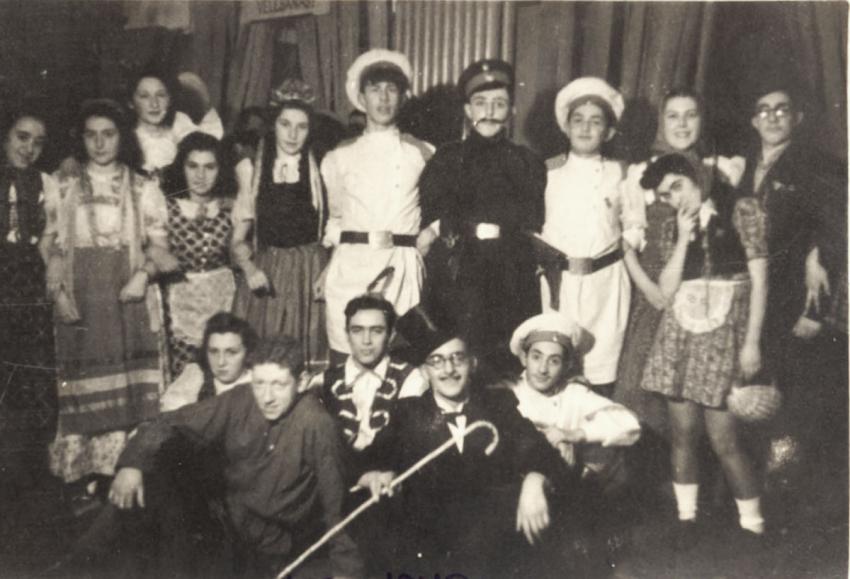Riga was the capital of Latvia and the cultural center of Latvian Jewry. In the mid 1930s, there were approximately 43,000 Jews living there, about one tenth of the total population. The Jews had an important economic role in the city: More than half of Riga's large factories, close to half its big businesses, and five of its merchant banks were owned by Jews. Many of the Jews of Riga owned small and medium-sized businesses, or were artisans and bureaucrats. Approximately half of Riga's doctors were Jewish, and 25 percent of its lawyers. Zionist parties and youth movements were active there, as well as the Bund and Agudat Israel parties. In addition, there were Jewish student and sports unions, Jewish newspapers and periodicals, and a Jewish theater, conservatory and choir.
After the Latvian coup d'etat in 1934, democracy became a thing of the past in Latvia. Management of Jewish matters, including schooling, was handed over to Agudat Israel, as a response to which, many Jewish parents chose to send their children to Latvian public schools.
In June 1940, Riga was annexed, along with the rest of Latvia, by the Soviet Union. Many of the Jews, who were communists or communist supporters, expressed their satisfaction with this development. In contrast, most Christian Latvians saw the Soviet occupation as undesirable, and this difference of opinion deepened the hostility between Latvians and Jews.
The Soviet occupiers nationalized the banks, large factories and businesses. The Jews were more affected by this than the general population, due to the high proportion of Jewish business owners, although many of them subsequently found work as consultants. The Jews also started entering municipal and state institutions that had previously been closed to them, including the police and security forces. The number of Jewish students in academic institutions doubled. As a result of these new opportunities, many young Jews flocked to Riga from the surrounding cities and towns, raising the number of Jews in the city to some 50,000.
At the same time, Jewish political activity was brought to a halt. The Jewish parties and youth movements were disbanded, communal institutions were closed, and the Jews had to work on the Sabbath and holidays. The Jewish educational system was forced to follow communist curricula, but Jewish schools changed their language of instruction to Yiddish, and the State Yiddish Theater was dedicated in Riga in October 1940.
On 14 June 1941, the authorities started to arrest thousands of Riga Jews defined as "hostile to the Soviet regime" and to deport them to Siberia. These included Zionist activists, Revisionists, Bundists, members of Agudat Israel, "bourgeois" Jews, and about 250 Jewish refugees from Germany and Austria.
When the Germans invaded the Soviet Union on 22 June 1941, the Red Army retreated from Riga. They were joined by at least 5,000 Jews, but many Jewish refugees from other cities were trapped in the city.
On the eve of the German occupation, there were approximately 40,000 Jews in Riga. Riga fell into German hands on 1 July 1941. In the course of July, Latvians who were members of extremist nationalist organizations arrested thousands of Jews.
Between July and October, the Germans issued a series of anti-Jewish decrees. The Riga ghetto was established in August, and by October: 32,000 Jews were confined there.
On 30 November 1941,German SS soldiers entered the ghetto accompanied by Latvian policemen. Some 800 Jews, including babies and the elderly, were murdered in the ghetto, and some 15,000, mostly women, were forced to march in the freezing cold to the Rumbula forest, 8 km away, while Latvian locals looked on. They were murdered and their bodies were thrown into pits that had been prepared in advance. A further 950 German Jews who had arrived that day to Riga on the transport that left Berlin on 27 November 1941, were murdered during this Aktion, in the course of which the Germans were assisted by Latvian policemen.
The vast majority of Riga Jewry was murdered by the end of the war. Most were murdered in Aktions, the remainder in forced labor camps.
The Red Army liberated Riga in October 1944.







